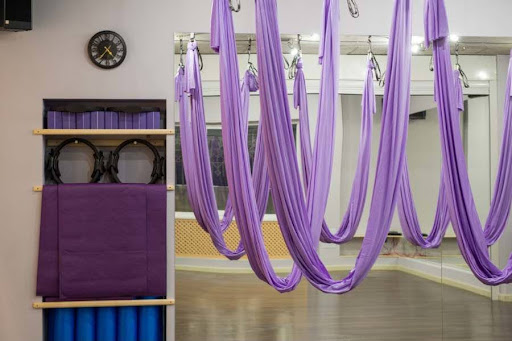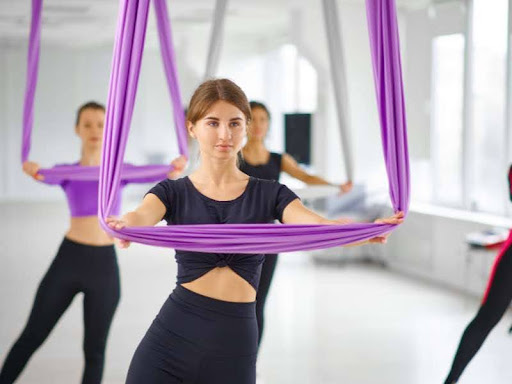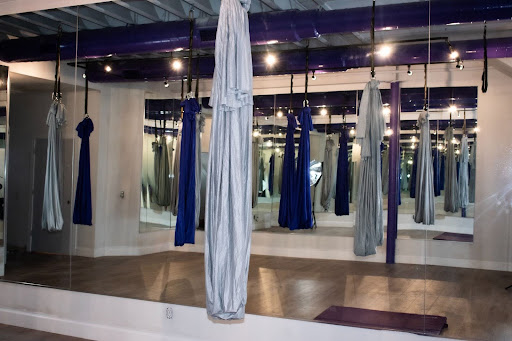
To practice aerial yoga safely and comfortably at home or in yoga studios, having the proper equipment is essential. From choosing the right hammock fabric and size to properly installing rigging points and attachments, selecting suitable gear requires careful consideration.
This guide will explore all of the fundamental aerial yoga equipment you need as a beginner. You’ll learn about the critical components like hammock swings, rigging equipment, mats, and other accessories that support your practice. We’ll also provide guidance on maintenance, cleaning, and safety precautions to implement to get the most out of your gear over the long term.
Essential Aerial Yoga Equipment

Aerial yoga, a unique fusion of traditional yoga and aerial arts, requires specific equipment to ensure safety, comfort, and effectiveness.
Aerial Hammocks/ Aerial Swings
- Material: An aerial yoga hammock is typically made from high-strength, low-stretch fabrics. The most common material is parachute silk, known for its durability and comfort. Some hammocks are made from a blend of nylon and polyester, offering a balance of support and slight elasticity.
- Weight Capacity: It’s crucial to choose a hammock with an appropriate weight capacity. Standard hammocks can generally support between 300-600 pounds, but it’s always best to check the specifications of the individual product and know your entire body weight.
- Size and Width: The width and length of the hammock can vary. A standard size is about 9 to 11 feet in length, which accommodates most heights and allows for a variety of poses. Widths can range from 6 to 9 feet, with wider options offering more coverage and support.
- Color and Texture: While not impacting functionality, color and texture are personal choices that can enhance your aerial yoga experience. Bright colors can uplift moods, while a soft texture can provide added comfort.
Rigging Equipment
- Ceiling Mounts: These permanent fixtures are secured to ceiling beams or joists and are the most stable option for aerial yoga. Ensure that the mounts are compatible with the structure of your home or studio.
- Free-Standing Rigs: A great alternative for those unable to install ceiling mounts. These rigs can be set up in larger spaces and are portable, though they tend to be a larger investment.
- Carabiners and Swivels: Carabiners are used to securely attach the hammock to the rigging point. Swivels, while optional, allow the hammock to rotate smoothly, which can be particularly beneficial for certain poses and sequences.
- Daisy Chains or Webbing Straps: These are used to adjust the height of the hammock. Daisy chains offer multiple loops for easy adjustment, while webbing straps provide a more custom length adjustment.
Mats and Padding
- Yoga Mats: A thick yoga mat placed beneath the hammock provides cushioning for floor work and a safety buffer. Look for mats with a thickness of at least 1/4 inch for optimal comfort.
- Crash Pads: For more advanced practices involving higher risks, crash pads offer extra safety. They can be placed over the yoga mat for additional cushioning during complex inversions or acrobatics.
Selecting the right aerial yoga equipment is essential for both the enjoyment and safety of your practice. Quality and suitability should be your top priorities when choosing your aerial yoga gear.
Additional Supportive Gear
While aerial hammocks and rigging are fundamental to aerial yoga, there are additional pieces of gear that can significantly enhance your aerial yoga practice whether you’re at home or in an aerial yoga class.
Here’s a closer look at some supportive items you might consider:
Appropriate Clothing For Aerial Fitness
Fabric and Fit: Opt for moisture-wicking, breathable fabrics that allow for ease of movement. Clothes should be form-fitting to prevent snagging or tangling in the hammock. Avoid zippers, buttons, or anything that might catch or tear the fabric.
Coverage: Long leggings and long-sleeve tops are recommended. They protect your skin from friction burns or irritation while moving in and out of the hammock.
Footwear: Generally, aerial yoga is practiced barefoot to prevent slipping and provide better tactile feedback. However, in cooler environments, non-slip socks might be preferred.
Grip Aids
Types: Grip aids can vary from chalk powders to grip-enhancing gloves or sprays. They are particularly helpful for those with sweaty hands or for added security during more advanced poses.
Application: Apply sparingly to the palms or the fabric for improved grip. If using gloves, ensure they fit snugly and do not impede your natural grip.
Cushions and Bolsters
Purpose: These provide extra support, comfort, or elevation for various poses. They can be particularly helpful for beginners or those with limited mobility.
Types: Bolsters come in different shapes and sizes – cylindrical, rectangular, or half-moon. Choose based on the specific support they offer for your practice.
Protective Gear
Wrist Guards: For those with weak wrists or for added support during weight-bearing poses.
Knee Pads: Useful for poses that put pressure on the knees or when practicing on a harder surface.
Headbands and Hair Ties
Use: To keep hair securely tied back and away from the face. This is not only for comfort but also for safety, as loose hair can get tangled in the hammock.
Water Bottle
Hydration: Aerial yoga can be an intense workout. Keeping a water bottle close by ensures you stay hydrated throughout your practice.
Towel
Usage: For wiping sweat during practice or laying over the hammock for added hygiene and comfort.
Each of these items enhances the aerial yoga experience, ensuring comfort, safety, and focus during your practice. While not all are essential, they can make a significant difference, especially as you progress and spend more time practicing aerial yoga.
Maintenance of Aerial Yoga Equipment

Proper maintenance of aerial equipment is crucial for longevity and safety. Here’s a detailed guide on how to care for your gear:
Cleaning A Yoga Hammock
Frequency: Regular cleaning is essential, especially if used frequently or in a shared setting. Aim to wash your hammock every 1-2 months, depending on usage.
Method: Most hammocks can be machine washed on a gentle cycle with mild detergent. Avoid bleach and fabric softeners as they can degrade the fabric’s integrity.
Drying: Air dry your hammock away from direct sunlight, as UV rays can weaken the fabric over time. Do not use a tumble dryer.
Inspecting Rigging Equipment
Routine Checks: Examine carabiners, swivels, and mounts for signs of wear, such as rust, deformation, or unusual creaks.
Replacement: Any rigging component showing signs of wear should be replaced immediately. Even small defects can significantly compromise safety.
Checking the Hammock Fabric
Visual Inspection: Regularly inspect the fabric for tears, holes, or thinning areas. Pay special attention to seams and attachment points. You will benefit from hanging upside down safely and easily.
Handling Damages: Small tears can turn into significant risks. If damage is spotted, replace the hammock immediately.
Aerial Yoga Safety Precautions

Regular Equipment Inspection
Implement a scheduled routine for inspecting all equipment components. This includes checking the hammock fabric, rigging points, carabiners, and the stability of any freestanding rigs.
Periodically, have a professional inspect your setup, especially if you have ceiling-mounted equipment.
Safety Tips for Aerial Yoga Classes
Start Slow: Especially for beginners, it’s important to gradually ease into more complex poses. Begin with basic stretches and positions before attempting inversions or acrobatic maneuvers.
Understand Limits: Recognize your physical limits. Pushing beyond your comfort zone too quickly can lead to strains or injuries.
Spotters for Complex Poses: For advanced poses or when trying something new, having a spotter can provide additional safety.
Stay Informed: Keep up-to-date with best practices in aerial yoga safety. This can include attending workshops, reading relevant materials, or consulting with experienced practitioners.
Emergency Procedures
Have a clear plan in case of a fall. This includes knowing how to land safely and having a padded surface beneath the hammock.
Maintaining your aerial yoga equipment and adhering to safety precautions are not just one-time tasks but ongoing commitments in the aerial industry. Regular maintenance ensures the longevity and safety of your gear while adhering to safety guidelines ensures your aerial yoga practice remains both enjoyable and safe.
Exploring Beyond Aerial Yoga
While aerial yoga predominantly features yoga hammocks or swings, the aerial industry encompasses a variety of other equipment that offers diverse and exciting ways to exercise through aerial yoga.

Aerial Hoop (Lyra)
An aerial hoop is a circular steel apparatus suspended from the ceiling, used for performing aerial acrobatics. It provides a frame for a wide range of movements and poses. Unlike the supportive fabric of the aerial hammock, the rigid structure of the hoop offers a different challenge, focusing more on strength, flexibility, and balance.
Aerial Silks
Aerial silk, also known as aerial fabric, involves performing aerial acrobatics while hanging from a special fabric. It requires significant strength, flexibility, and grace.
Static and Flying Trapeze
These are traditional circus equipment, with the static trapeze being more accessible for beginners. Both offer unique challenges and exhilarating experiences.
In Summary
Aerial yoga or anti-gravity yoga is an exciting discipline that offers immense physical and potential mental benefits. Incorporating aerial yoga into your fitness regime can uplift active lifestyle, adding fun and grace to your regular exercise routine. But having the right equipment is imperative for a safe, effective, and enjoyable aerial journey. Investing in a high-quality hammock, secure rigging equipment, and supportive accessories provides the essential foundation. Just as critical is maintaining your setup through regular inspection and care. Start slow, understand personal limits, use spotters when appropriate, and have emergency plans in place.